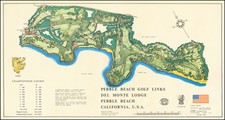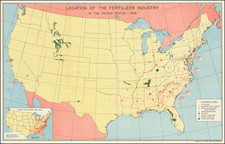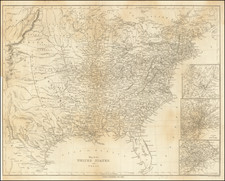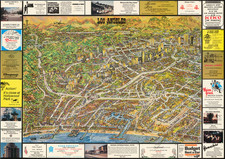Rare Civil Rights Era Pictomap of the Contributions Made by Black Americans to Society.
Rare pictorial map of the United States focusing on the Black American who contributed to science, politics, arts, and culture during the first half of the 20th century. The map was compiled by the great African American artist Louise E. Jefferson for the National Council of Churches.
This map celebrates the considerable achievements of black Americans in all walks of life: writers, artists, scientists, educators, entertainers, athletes, and the men and women who worked the land and built the country from the ground up. The map depicts these citizens at work on a backdrop of a United States map, surrounded by photographs of some of these figures. The title is overlain on a map of Africa, and a description of the map reads:
This pictomap shows some of the outstanding Negroes in American life today and the various fields of endeavor in which others have excelled. Many not pictured or named here have made equally notable contributions to the progress of the Negro specifically and of the nation generally, but because of space limitation it is not possible to delineate their achievements. The information presented is intended to be representative rather than inclusive.
Louise E. Jefferson
The following Biography is excerpted from the Tulane University website:
Jefferson was born in Washington, D.C. in 1908 . . . the only child of Louise and Paul Jefferson. Her father was a calligrapher for the United States Treasury, and her mother made a living playing piano and singing aboard cruise ships on the Potomac River. . .
Louise began her training at Hunter College in New York City where she studied fine art, and then on to Columbia University where she studied graphic arts. During her time in New York City, Jefferson became involved with the Harlem Artist’s Guild, and is credited as a founding member. She was an active member of the artistic community during the Harlem Renaissance, and she became close friends with poet Langston Hughes, and shared an apartment with Pauli Murray, who would become an influential activist, lawyer, and priest.
At the start of her career, Jefferson designed posters for the YWCA in New York City, until she was discovered by the Friendship Press, the publishing branch for the National Council of Churches. By 1942, Jefferson was the Artistic Director for the Friendship Press and she had control of every aspect of the Press’s book productions. While working for Friendship Press, Jefferson also accepted freelance work from publishing companies Doubleday, Macmillan, and Viking, and also from the University presses of Columbia, Oxford, Rutgers, and Syracuse. Jefferson would retire from the Friendship press in 1960, but she remained busy designing book jackets and maps for publishing companies and Universities.
Once retired, Jefferson set her sights on the most ambitious project of her life. Over the course of several years, Jefferson made five trips to Africa to do research for what would become her book, The Decorative Arts of Africa. She travelled the continent extensively, visiting Cameroon, the Democratic Republic of the Congo, Egypt, Gambia, Ghana, Guinea, Liberia, Mali, Niger, Nigeria, Senegal, South Africa, Sudan, Uganda, and Zimbabwe. Jefferson used her photographs and drawings from her adventures to create The Decorative Arts of Africa, which was published in 1973. Containing over 300 illustrations, Louise describes her book “as a visual sampling of what the spirit and tempo of the African artist’s role has been in the past and what it continues to be today.”
In her later years, Jefferson settled down in the picturesque town of Litchfield Connecticut, where she maintained an art studio and could always be found with her beloved camera, ready to capture a photo at a moment’s notice. She spent the last few years of her life tending to her garden, entertaining friends, and taking snapshots around Litchfield. Louise Jefferson passed away in 2002 at the age of 93.
The Louise Jefferson papers are held by the Amistad Research Center at Tulane University.
Rarity
The map is rare. This is the second example we have ever seen on the market.
The following Biography is excerpted from the Tulane University website:
Jefferson was born in Washington, D.C. in 1908 . . . the only child of Louise and Paul Jefferson. Her father was a calligrapher for the United States Treasury, and her mother made a living playing piano and singing aboard cruise ships on the Potomac River. . .
Louise began her training at Hunter College in New York City where she studied fine art, and then on to Columbia University where she studied graphic arts. During her time in New York City, Jefferson became involved with the Harlem Artist’s Guild, and is credited as a founding member. She was an active member of the artistic community during the Harlem Renaissance, and she became close friends with poet Langston Hughes, and shared an apartment with Pauli Murray, who would become an influential activist, lawyer, and priest.
At the start of her career, Jefferson designed posters for the YWCA in New York City, until she was discovered by the Friendship Press, the publishing branch for the National Council of Churches. By 1942, Jefferson was the Artistic Director for the Friendship Press and she had control of every aspect of the Press’s book productions. While working for Friendship Press, Jefferson also accepted freelance work from publishing companies Doubleday, Macmillan, and Viking, and also from the University presses of Columbia, Oxford, Rutgers, and Syracuse. Jefferson would retire from the Friendship press in 1960, but she remained busy designing book jackets and maps for publishing companies and Universities.
Once retired, Jefferson set her sights on the most ambitious project of her life. Over the course of several years, Jefferson made five trips to Africa to do research for what would become her book, The Decorative Arts of Africa. She travelled the continent extensively, visiting Cameroon, the Democratic Republic of the Congo, Egypt, Gambia, Ghana, Guinea, Liberia, Mali, Niger, Nigeria, Senegal, South Africa, Sudan, Uganda, and Zimbabwe. Jefferson used her photographs and drawings from her adventures to create The Decorative Arts of Africa, which was published in 1973. Containing over 300 illustrations, Louise describes her book “as a visual sampling of what the spirit and tempo of the African artist’s role has been in the past and what it continues to be today.”
In her later years, Jefferson settled down in the picturesque town of Litchfield Connecticut, where she maintained an art studio and could always be found with her beloved camera, ready to capture a photo at a moment’s notice. She spent the last few years of her life tending to her garden, entertaining friends, and taking snapshots around Litchfield. Louise Jefferson passed away in 2002 at the age of 93.














![[WWII War Bonds] As](https://storage.googleapis.com/raremaps/img/small/63461.jpg)

![Index Map of the Civil Code of California Designed and Executed By Curtis Lindley . . . [bound into] Revised Laws of the State of California; In Four Codes: Political, Civil, Civil Procedure and Penal . . .](https://storage.googleapis.com/raremaps/img/small/84298.jpg)